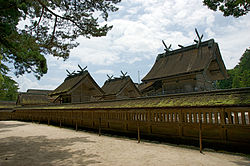This article has an unclear citation style .(November 2023) |
| Izumo clan | |
|---|---|
 Izumo Taisha, the traditional shrine of the family | |
| Home province | Izumo Province |
| Parent house | Kuni no miyatsuko |
| Founder | Ame no Hohi |
| Current head | Takamasa Senge (千家尊祐) |
The Izumo clan is a Japanese noble family descended from Ame no Hohi who used to rule Izumo Province and run Izumo Taisha today. [1] [2] [3] [4]
Contents
The clan were originally Kuni no miyatsuko but after the abolition of the role they took on a priestly role at Izumo-taisha, they share this history with the Aso clan of Aso Shrine, the Owari clan of Atsuta Shrine, the Munakata clan of Munakata Taisha, [3] and the Yamato clan of Ōyamato Shrine.
From the beginning the role of Izumo no Kuni no Miyatsuko was seen as substantially more important than the other Kuni no miyatsuko. [4]
They held the position of Kuni no miyatsuko of Izumo Province. They now run Izumo-taishakyo as the Senge family.[ citation needed ] The head of the family was still called the Kokuzo or Kuni no MIyatsuko in the medieval period, long after the Kuni no Miyatsuko of other provinces ceased to be relevant. [5]
Their position as a religious authority is sometimes seen as in contrast to the Yamato as an "other Japan". Their religious authority was somewhat unusual among Kuni no Miyatsuko due to being in a religiously significant location. [6] They were likely a rival clan to the Imperial House of Japan early on, with the relationship of their subordination being mythologized as a mutual compromise in the Kojiki and Izumo no Fudoki. [7]
They are descendants of Amenohohi-no-mikoto (天穂日命), the second son of Amaterasu-ōmikami (天照大御神), the sun goddess whose first son is the ancestor of the imperial family, have been, in the name of Izumo Kokuso (出雲国造) or governor of Izumo, taking over rituals because when Izumo-taisha was founded Amenohohi-no-mikoto rendered service to Okuninushi-no-kami. Ame no Hohi was sent to run Izumo Taisha for Susanoo when the transfer of land occurred as part of the agreement. [8]
The family's conflict around 1340 made them separated into two lineages, Senge (千家) and Kitajima (北島). This occurred because of a dispute related to the eldest son being too sickly to perform the physically demanding Fire drill succession ritual to become Kokuzo. [5] The older line became Senge (千家) and the younger became Kitajima (北島). [4]
After the separation those two families took the position of Izumo no Kuni no Miyatsuko by turns until the late 19th century. Shinto was reconstructed as modernized Japan's national religion in the late 19th century. In 1871, Izumo-taisha was designated as an Imperial-associated shrine and the government sent a new administrator so Izumo no Kuni no Miyatsuko families were no more the administrators of Izumo-taisha. Senge and Kitajima established their religious corporations respectively, Izumo-taisha-kyo (出雲大社教) by Senge and Izumo-kyo (出雲教) by Kitajima.
Takatomi Senge was the 80th high priest of Izumo-taisha and founded Izumo-taishakyo after the shrine was seized by the Government of Meiji Japan. [9] [10]
Under the Allied occupation after World War II, Shinto was separated from the government control and Izumo-taisha was reformed into a private shrine, then Senge and its Izumo-taisha-kyo took back the position of the administrator of Izumo-taisha. Takatoshi Senge (千家尊祀), the 83rd-generation Izumo no Kuni no Miyatsuko of Senge lineage, was chosen to be the chief priest of Izumo-taisha in 1947. He died in February 2002 at the age of 89.[ citation needed ]
Currently, the position of the administrator of Izumo-taisha is succeeded by Senge lineage. Its Izumo-taisha-kyo is better known nationwide and has more followers in total, "出雲大社 千家 尊統 (1998/8)", but locally Kitajima lineage and its Izumo-kyo has more followers around Izumo region. Kitajima is the more orthodox Izumo no Kuni no Miyatsuko. "出雲国造系統伝略 北島斉孝 (1898)". On October 5, 2014, Kunimaro Senge, eldest son of the current administrator Takamasa Senge, married Princess Noriko at the shrine. Noriko is a daughter of the late Prince Takamado, a cousin of the now-Emperor Emeritus of Japan. [11]
